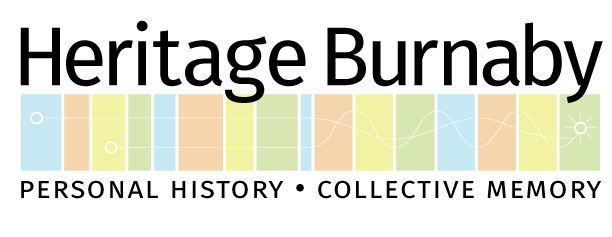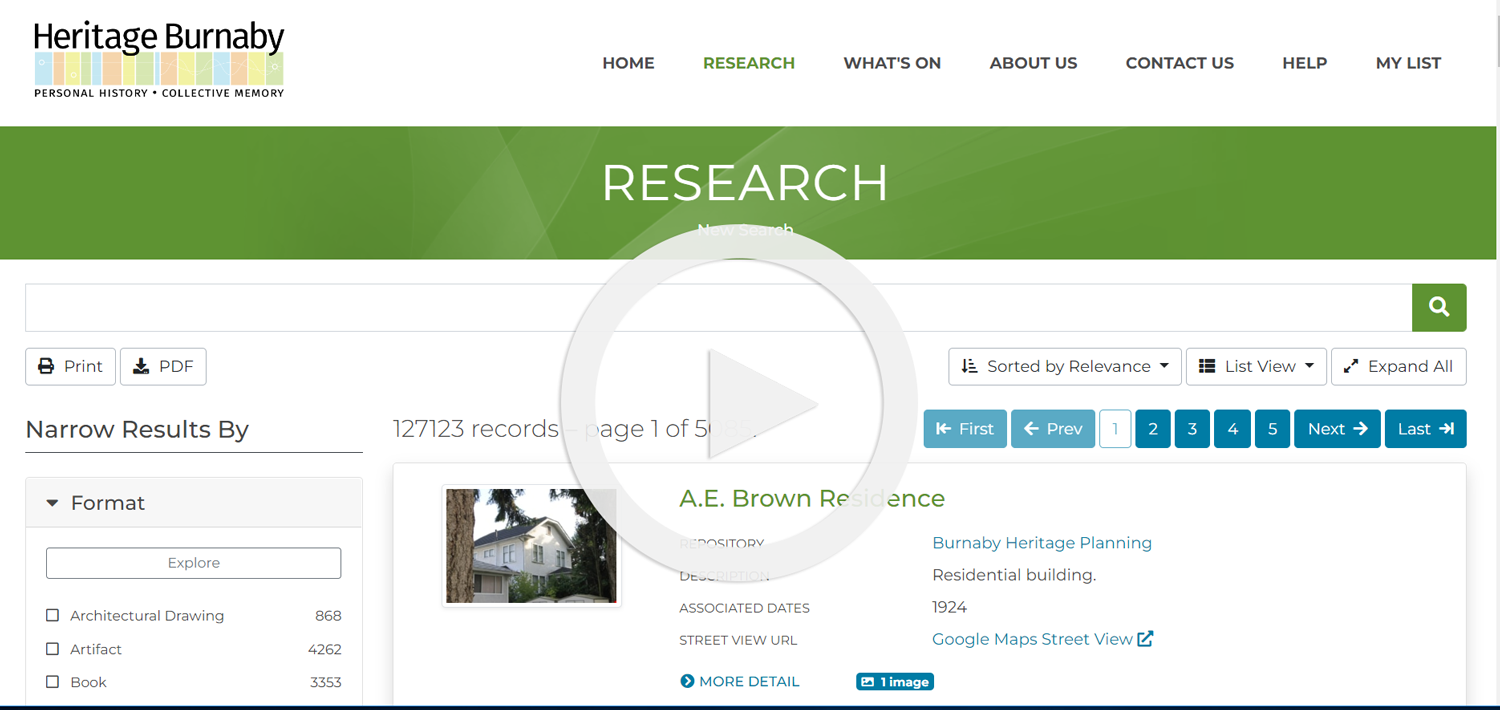Help Video
Help Guides
- General Tips on Using Heritage Burnaby
- Searching for City Bylaws
- Searching for City Council Meeting Minutes and Reports
Frequently Asked Questions (FAQ)
The easiest way to begin learning more about your home and neighbourhood is to use the curated collections: the Current Neighbourhood and the Historic Neighbourhood. These links provide a listing of all of the records that relate to the region you are interested in. You can further refine the results listed by using the “Narrow By” facets as necessary.
In most cases, we do not have a digital version available online. This may be because the items hasn't yet been scanned. In other cases, privacy concerns may prevent the public publication of a document. Please contact the repository for a record to find out how you can view it.
To obtain a high resolution copies for commercial use, or for the inclusion in published material, you need to contact the repository who holds the record you want to obtain a copy from. Please make sure that a link to the original record is included and cited appropriately. If there are no copyright or donor restrictions regarding reproductions, high resolution digital copies will be released. Photographs whose copyright are owned by third parties can only be released for Fair Dealing purposes under the Canadian Copyright Act.
For contact information, click Contact Us.
At the bottom of any record, click Add to List. Please note this list is only maintained for your current browser session.
To access bookmarked records, navigate to My List along the top menu to the far right-hand side. You can print, download, and email this list from this page to access them after your browser session ends. When you close the browser window, the list is cleared.
A Feedback button appears on every record on Heritage Burnaby. When you click that button, a direct permalink is created and an email is generated.
You may also add a number of items together using the "My List" feature and send us feedback on several items by email.
Please also refer to the Contact Us page for a list of repositories, phone numbers, emails, and addresses.
The Research page is useful for browsing the collections by Subject, Person, or Place. For example, you may know the first letter of a name, but aren’t sure about the spelling. Or you are interested in browsing records we have related to Hastings Street, or other geographic landmark in Burnaby. You browse these terms alphabetically on the “Browse” tabs.
The advanced search features on this page allow you to search for a key word or phrase, while adding or omitting certain phrases. For example, you are searching for the key word “Herbalist” and excluding or including only record that begin with this accession number HV975.5.*.
The advanced search can build a query with a more precise date range. You can type the date range, while the “Narrow By” facet requires selecting multiple decades.
This page also give quick access to specific types of records in one click, such as all images, council records, bylaws, all digital books, all audios and videos, and more.
Yes, there are hundreds of aerial photographs available. The easiest way to find them is to use this link. You can also navigate to the Research page, and click on the 'Browse by Subject' tab. Choose the subject term “Aerial Photographs”. Low resolution images are available for personal use and Fair Dealing purposes, although most aerial photographs remain the copyrighted property of the Government of B.C.. For commercial use, or for the inclusion in published material, contact us.
If you are searching for specific people by their names, in addition to simply typing their names, the proximity operator is a great tool, as are the Browse Indexes. When a name may be spelled in different ways, the wildcard operators can help find those variations, as can the Boolean OR operator.
Examples
"Allan Smith"~4
All?n
Allan OR Allen OR Alan
PDF item is classified as a document. Heritage Burnaby also has 16 digital books available to read online as a flip book viewer or as a PDF download. These digital books are easiest to access from the Research page.
Keyword searches will include words within digital books, but not always within a PDF. For PDF items, the search only picks up the words used to describe the document, not the words in the document itself.
Most records on Heritage Burnaby can be shared on social media by using the Share feature located beneath each description. The Share feature is not available for Council Records but they can be saved by creating a Permalink. A Permalink can be created for any record description on the website. When clicking on the Permalink button a window will open that displays the record and allows you to copy and paste the permanent URL.
Basic Search Tips
Sorting Search Results
Search results are almost always sorted first by relevance, so that the items that best match your search appear first. Depending on the types of items available in this site, you may be able to sort your results by the item's title or a date associated with it.
Changing the View of Search Results
Search results are initially shown in a list view, with brief information about each result. You can view more information about each item by selecting the "More Detail" link. Selecting "Less Detail" will re-display the brief view of the item. The "Expand All" button at the top of your search results can expand them all for you at once.
You may also be able to change the view to a gallery-style view, focusing on images and book covers or document cover pages, or a table-style view, with very brief information.
Viewing Related Records
When viewing individual records, some terms in the record may appear as links, especially for names, places and topics. Choose any of these links to find all records with that term.
A "More Like This" or "Similar" button may appear with each record. Choose this to find other records which the search engine determines have something in common with this record.
Advanced Search Tips
The additional search options listed here can be used as described, on their own, or in combination with each other. They may be used in the general search box, as well as anywhere on the Advanced Search Form.
Combining Search Terms with Boolean Operators
You can combine search terms with the AND, OR, and NOT Boolean operators (in capitals).
Multiple search terms are automatically assumed to be combined with AND, but you can combine the search terms explicitly by typing out AND between the terms. Use AND for searching when you want results that match both (or more) search terms.
e.g., to search for documents that contain both forest and rock, in the search bar, type:
forest AND rock
To look for records that match any one of your search terms, use OR.
e.g., to search for documents that contain either forest or rock, in the search bar, type:
forest OR rock
Use NOT if you would like to include one search term but exclude another.
e.g., to search for documents that contain forest but do not contain rock, in the search bar, type:
forest NOT rock
Prepositions such as a, an, the and other "small" words, often referred to as "stopwords" are generally ignored by the search engine. There's no need to specifically exclude them with NOT.
Grouping Terms
You can use parentheses to group terms and phrases. This can be very useful if you want to control the Boolean logic for a query.
e.g., to search for documents that contain both forest and rock, but not water, in the search bar, type:
(forest AND rock) NOT water
Phrase Searches
To search for an exact phrase, enclose the phrase in quotation marks in the search bar.
e.g., to search for documents that contain the exact words rock in a forest, type:
"rock in a forest"
Wildcard Searches
Wildcard searches can be used when you do not know the exact term you are searching for, or if you wish to look at variations of your search term.
e.g., to find results that match text or test, you can use the ? symbol and search for:
te?t
The ? symbol is used in place of a single character. To search for multiple unknown characters, use the * symbol.
e.g., to find results that match test, tests, tester, testing, or any other variation that begins with test, search for:
test*
The * symbol can be used in the middle of a term.
e.g., to find test, tempest, tenet, etc. (i.e., any words that begin with "te-" and end in "-t"), search for:
te*t
You can also use the ? and * symbols at the start of a term.
e.g., to search for test, harvest, forest, etc. (i.e., any words that end in "-est"), search for:
*est
Proximity Searches
To search for documents that have two terms within a certain number of words of each other, use the ~ symbol with a number.
e.g., to search for the terms forest and rock within 10 words of each other, search for:
"forest rock"~10
where the desired terms are in quotation marks, followed immediately by the ~ symbol and a number.
This is especially useful for name searches, where a name may include first name, last name, middle initial or title, in any order, and a search result may also include other similar first or last names. If the name of the person you are searching for was 'Jane Doe' try a search for:
"Jane Doe"~3
to find variations such as:
- Jane Doe
- Doe, Jane
- Jane M. Doe
- Doe, Jane Margaret
- Ms. Jane Margaret Doe
but exclude names such as:
- John Doe
- Margaret Smith
- Jane M. Doe
that are also in the document and which would be found by a simpler search.
Fuzzy Searches
The ~ symbol can also be used for approximate searches, but only when a single word is being searched.
e.g., to search for terms that are similar in spelling to cat, search for:
cat~
This will bring back results that match terms like bat, rat, mat and hat, in addition to cat.
Range Searches
To perform a range search, use the [ ] symbols and the word TO (in all capitals).
e.g., if you're searching for names that fall alphabetically between Jones and Smith, search for:
[Jones TO Smith]
You can also search a range of numbers using the same method.
e.g., if you're searching for documents from between 2006 to 2008, inclusive, search for:
[2006 TO 2008]
Boosting a Term
To give one search term more importance over another, you can use the ^ symbol followed by a number.
e.g., if you want to search for documents with both forest and rock, but forest is the more important search term, search for:
rock forest^5
which will give the term forest 5 times the value of the term rock.

